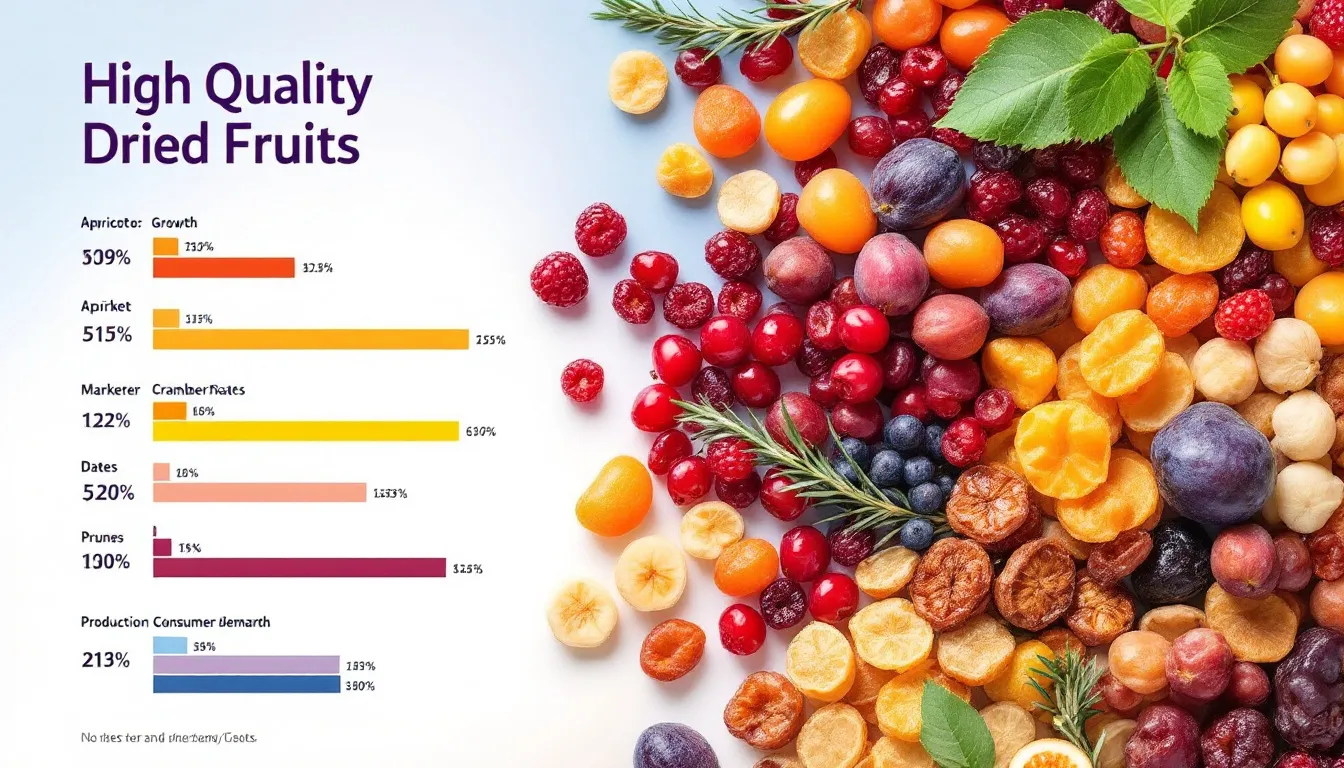Curious about how profitable starting your own dry fruits business is? The typical dry fruits business profit margin ranges from 5-10% annually. Key factors like sourcing quality, operational costs, and market demand all play significant roles. This article delves into these elements and offers essential tips to improve your margins.
Key Takeaways
- Understanding profit margins and sourcing high-quality dried fruits are essential for maximizing profitability in the business.
- Effective pricing strategies, reducing operational costs, and leveraging seasonal demand can significantly enhance profit margins.
- Implementing customer feedback and monitoring market trends ensure a competitive edge and continual adaptation to consumer needs.
Understanding Profit Margins in the Dry Fruits Business

Profit margins in the dry fruits business represent the difference between the cost of goods sold and the selling price, a key indicator of profitability. In India, the profit margin for the dry fruits business typically ranges from 5-10% annually, reflecting a healthy return on investment thanks to high consumer demand driven by the health benefits of dried fruits.
Starting a small dried fruit business requires a modest investment, but it offers significant potential for growth. Entrepreneurs can begin with a small operation, build their brand, and expand over time, making it a feasible and attractive venture.
Exporting dry fruits can significantly increase revenue and profit margins since bulk sales to overseas clients often yield higher returns. India’s dry fruit business is particularly lucrative due to its vast wholesaler network and extensive distribution in the Indian market, making it fertile ground for both small and large-scale businesses.
Key Factors Influencing Profit Margins
Several key factors influence profit margins in the dry fruits business, with sourcing costs being a primary consideration. Sourcing costs can fluctuate based on seasonality, quality, and supplier relationships. Building solid relationships with suppliers can lead to significant discounts, potentially reducing costs by around 15% on organic dried fruit purchases.
Traditional Indian sweet shops are significant consumers of dry fruits, particularly almonds and raisins, which they use to make a variety of traditional sweets. Their demand for these ingredients can greatly impact profit margins.
Operational expenses like rent and labor also significantly impact overall profitability. Seasonal changes can affect demand for dry fruits, influencing profit margins throughout the year. Additionally, business location can influence profitability; high-traffic areas may justify higher prices, boosting profit margins.
Sourcing High-Quality Dried Fruits

Sourcing high-quality dried fruits is crucial for profitability and customer satisfaction. High-quality products command better prices and foster customer loyalty and repeat business. Achieving this requires maintaining strong connections with reliable growers. Knowing the best practices and optimal harvesting times helps ensure you source the highest quality dried fruits.
The demand for roasted dry fruits is significant in sweet shops, dessert shops, baking shops, and catering services. These markets utilize roasted dry fruits like almonds and cashews in creating traditional sweets, as toppings for desserts, ingredients in baked goods, and as starters in events.
Transparent sourcing practices are crucial. Allowing consumers to trace product origins can increase trust in your brand. Effective quality control measures, such as sensory evaluations and moisture content checks, are vital for maintaining the high standards expected by customers.
Incorporating customer suggestions into product development can further enhance satisfaction and loyalty. This feedback loop ensures you continually meet consumer expectations, crucial in a competitive market. Prioritizing reliability and quality in sourcing sets your business apart in the crowded dry fruit market.
Effective Pricing Strategies
Effective pricing strategies are crucial for maintaining healthy profit margins in the dried fruit sector. Understanding production costs is the first step in setting prices that ensure profitability. Analyzing market competition helps establish price points that attract customers while maintaining margins.
Consumer perception of value greatly influences final product pricing. In a competitive landscape, adjusting pricing strategies to reflect market conditions is necessary to maintain profitability. Balancing cost, competition, and customer perception helps set prices that maximize profit margins.
Reducing Operational Costs
Reducing operational costs is crucial for improving profit margins. Expenses like rent, labor, and marketing significantly impact overall profitability. Scalable subscription platforms help manage both fixed and variable costs effectively. These platforms offer flexibility, allowing operations to scale based on demand.
Data-driven marketing strategies can maximize ROI on advertising expenditures. Leveraging analytics helps identify the most effective marketing channels and optimize spending. Creating a systematic approach to handling customer feedback ensures actionable insights and integration into operational improvements.
Leveraging Seasonal Demand
Seasonal demand significantly influences sales and profitability. Sales of dry fruits often vary seasonally, with demand peaking during festive periods and holidays. Profit margins during these times can increase by 25-30%, making it essential to capitalize on these opportunities.
Offering sales deals and promotions during the holiday season can further boost profitability by attracting more customers. Understanding and capitalizing on peak seasons is crucial for maximizing sales and enhancing profit margins in the dry fruits business.
Enhancing Marketing Efforts
Effective marketing strategies are essential for increasing profitability in the dry fruits business. Such strategies can enhance brand loyalty and positively contribute to profit margins. Digital marketing is crucial for reaching a wider audience and attracting potential customers. A strong online presence, including a user-friendly website and engaging social media profiles, is essential for thriving in the dried fruit market.
Pay-per-click advertising provides immediate visibility and can enhance lead generation for dried fruit sellers. Content marketing, like sharing recipes and health tips, helps establish authority in the dried fruit niche and boosts organic traffic. Email marketing campaigns tailored to promotions and engaging content can further enhance customer engagement.
Social media platforms enable brands to emotionally connect with customers by sharing engaging content. A well-structured website enhances customer experience and improves search engine visibility. Combined, these strategies will significantly boost marketing efforts and profitability.
Diversifying Product Range
Diversifying your product range can enhance market presence and attract a broader consumer base. Offering a variety of products, including seasonal flavors, can increase repeat orders by 10-15% as customers anticipate exclusive offerings. This approach boosts sales and enhances customer satisfaction and retention.
Customizable snack boxes that align with dietary trends effectively attract health-conscious consumers in the food industry. Using customer feedback to adjust products and services ensures meeting consumer expectations and remaining competitive in the market.
Expanding product lines is a strategic move to grow the dry fruits business.
Investing in Quality Packaging
Investing in quality packaging is crucial for protecting the integrity of dried fruits during distribution and storage. Effective packaging must protect against moisture and provide mechanical protection to prevent damage during transportation. This ensures products reach consumers in the best possible condition.
Attractive packaging enhances product visibility and influences purchasing decisions. Sustainable packaging options are increasingly important for consumer appeal and environmental responsibility. Using mono-material packaging simplifies recycling and minimizes environmental impact.
Quality packaging is vital for marketing strategies and overall business success.
Utilizing Online Platforms
Utilizing online platforms is essential for expanding reach and increasing sales in the dry fruits business. The demand for dry fruits online remains consistently high, making it a lucrative eCommerce option. Building an online store helps establish a long-term business model for selling dry fruits.
Effective marketing strategies, including social media engagement and SEO, are crucial for driving traffic to an online store. Online platforms facilitate easy access to a larger customer base, enhancing the reach of the dried fruit business.
Leveraging the power of the internet presents a practical business proposition for selling dry fruits.
Targeting Health-Conscious Consumers
Targeting health-conscious consumers is a key strategy for success in the dry fruits business. Dried fruits are favored by health-conscious individuals for their rich content of vitamins, minerals, and antioxidants. Consumers increasingly prefer products with clean labels, boosting demand for natural and minimally processed dried fruits.
The growing trend towards vegan and plant-based diets has increased the use of dried fruits in healthy snacks and protein bars. Innovative product offerings, like probiotic-infused varieties, are essential to meet evolving consumer demands. Promoting healthy eating during festive periods taps into increased consumer interest in nutritious snacks.
Dried fruits and dehydrated fruits are versatile and used in various food segments, making them appealing to a wide range of health-conscious consumers. Focusing on health benefits and clean labels effectively targets this growing dried fruit industry segment.
Implementing Customer Feedback
Implementing customer feedback is essential for enhancing the customer experience and fostering loyalty. Positive and negative feedback should be acknowledged and acted upon to build trust with customers. Establishing a feedback loop allows companies to continuously gather customer insights and adapt strategies accordingly.
Adjusting prices or product offerings based on customer feedback and market research can enhance sales performance and market relevance. Listening to customers and making necessary adjustments ensures your business remains competitive and customer-centric.
Monitoring Market Trends
Monitoring market trends is crucial for staying competitive in the dry fruits business. The global dried fruits market is expected to grow significantly, reflecting a compound annual growth rate (CAGR) of 5.5%. Technological advancements in drying and processing methods are improving the safety and quality of dried fruits.
Adapting your business strategies based on these market trends and technological advancements will help maintain healthy profit margins. Staying updated with market trends ensures that your business can capitalize on new opportunities and remain relevant in the industry.
How to Start a Dry Fruits Business in India

Starting a dry fruits business in India involves several key steps, each crucial for establishing a successful venture. Here is a pointwise guide:
- Market Research: Analyze the dry fruit market to understand consumer preferences, demand trends, and competition.
- Business Plan: Develop a comprehensive business plan outlining target consumers, marketing strategies, distribution channels, and financial projections.
- Licenses and Registrations: Obtain essential licenses such as GST registration, MSME registration, and FSSAI certification to ensure legal compliance.
- Sourcing High-Quality Products: Establish relationships with reliable suppliers to source high-quality dried fruits and ensure consistent supply.Traditional Indian sweet shops require dry fruits like almonds and raisins to create sweet rice cakes, among other traditional sweets.
- Quality Control: Implement stringent quality control measures to check for discoloration, foul smells, and expiry dates to maintain product standards.
- Packaging: Invest in good quality packaging to prevent contamination and preserve the freshness of dry fruits during storage and distribution.
- Marketing Strategy: Utilize social media, advertising, and promotions to effectively differentiate your brand and attract customers.
- Distribution Network: Establish a robust distribution network, including retail stores and online platforms, to reach a wider audience.
- Leverage Seasonal Demand: Plan for peak seasons and festive periods to maximize sales through strategic promotions and inventory management.
- Monitor and Adapt: Continuously monitor market trends and customer feedback to adapt your business strategies and stay competitive.
By following these steps, you can successfully start and grow your dry fruits business in India, tapping into the increasing demand driven by rising health awareness.
Starting a Profitable Dry Fruits Business from Home

- Understand Local Regulations: Research and comply with local regulations, obtaining necessary licenses such as GST and FSSAI registration to operate legally.
- Develop a Business Plan: Create a comprehensive business plan outlining target customers, marketing strategies, and distribution plans to ensure a successful venture.
- Quality Packaging: Invest in high-quality packaging to maintain the freshness and integrity of dry fruits during storage and transport.
- Effective Marketing Strategies: Utilize social media, promotions, and other marketing channels to enhance the visibility and reach of your dry fruits business.
- Quality Control: Implement regular quality checks for discoloration, smell, and expiry dates to ensure that only high-quality products are sold.
- Source High-Quality Products: Build relationships with reliable suppliers to consistently source high-quality dried fruits.
- Leverage Online Platforms: Establish an online presence to reach a broader audience and facilitate easier sales transactions.
- Monitor Market Trends: Stay updated with market trends to adapt your business strategies and meet consumer demands effectively.
- Capitalize on Seasonal Demand: Plan inventory and promotions around peak seasons and festive periods to maximize sales.
- Customer Feedback: Continuously gather and implement customer feedback to improve products and services, ensuring customer satisfaction and loyalty.
Exploring Lucrative Import Opportunities in the Dry Fruits Market
- Research Market Demand: Identify which dry fruits are in high demand in your target market to ensure successful importing.
- Build Supplier Relationships: Establish connections with reliable suppliers in countries known for dry fruit production to secure a consistent supply of high-quality products.
- Understand Customs Regulations: Familiarize yourself with customs regulations in both exporting and importing countries to avoid legal issues and streamline the import process.
- Utilize Freight Forwarders: Engage freight forwarders to simplify logistics management and ensure smooth transportation of goods.
- Establish Distribution Channels: Partner with local grocery stores and health food shops to increase the sales of imported dry fruits.
- Create a Strong Online Presence: Develop an online platform to attract more customers and enhance the visibility of your import business.
- Leverage Online Platforms: Use eCommerce platforms to reach a broader audience and facilitate easier sales transactions.
- Monitor Market Trends: Stay updated with market trends to adapt your business strategies and meet consumer demands effectively.
- Capitalize on Seasonal Demand: Plan inventory and promotions around peak seasons and festive periods to maximize sales.
- Implement Customer Feedback: Continuously gather and implement customer feedback to improve products and services, ensuring customer satisfaction and loyalty.
Exciting Franchise Opportunities in the Dry Fruits Business

- Established Brand Recognition: Starting a franchise in the dry fruits business provides the advantage of leveraging an established brand, which helps in gaining consumer trust and market presence quickly.
- Operational Support: Franchises offer comprehensive operational support, including training, marketing strategies, and supply chain management, reducing the risks associated with starting a new business.
- Growing Market Demand: The increasing demand for dry fruits, driven by health-conscious consumers, makes this a lucrative market with ample growth opportunities.
- Health-Conscious Consumer Base: The dry fruits market benefits from a growing base of health-conscious consumers seeking nutritious snacks, which fuels demand and business success.
- Expanding Market Potential: With the rising popularity of healthy eating, the dry fruits market is expanding, offering significant opportunities for franchise growth and profitability.
- Scalability: Franchises in the dry fruits business are scalable, allowing entrepreneurs to expand their operations and increase their market share efficiently.
- Access to Proven Business Models: Franchisees benefit from a proven business model, reducing trial and error and improving the likelihood of business success.
- Marketing and Advertising Support: Franchises typically provide extensive marketing and advertising support, ensuring strong brand visibility and customer engagement.
- Strategic Location Advantages: Franchises often have the advantage of choosing strategic locations with high foot traffic, enhancing sales and profitability.
- Comprehensive Training Programs: Franchisees receive comprehensive training programs that equip them with the necessary skills and knowledge to run a successful dry fruits business.
Summary
Maximizing your dry fruits business profit margin requires a multifaceted approach. From understanding profit margins and sourcing high-quality products to leveraging seasonal demand and enhancing your marketing efforts, each strategy plays a crucial role. Effective pricing, reducing operational costs, and investing in quality packaging are essential for maintaining profitability. Utilizing online platforms and targeting health-conscious consumers can further boost sales and expand your customer base.
In conclusion, the dry fruits business offers significant potential for profitability with the right strategies in place. By staying updated with market trends, implementing customer feedback, and continuously adapting your business model, you can ensure long-term success. Take action today, and transform your dry fruits business into a thriving, profitable venture.
Frequently Asked Questions
What are the essential licenses needed to start a dry fruits business in India?
To establish a dry fruits business in India, it is essential to obtain GST registration, MSME registration, and FSSAI certification. These licenses ensure legal compliance and help in smooth operations.
How can I reduce operational costs in my dry fruits business?
To reduce operational costs in your dry fruits business, consider utilizing scalable subscription platforms and implementing data-driven marketing strategies, while also systematically addressing customer feedback. This approach can lead to greater efficiency and cost savings.
What are the benefits of diversifying my product range in the dry fruits business?
Diversifying your product range in the dry fruits business can significantly enhance your market presence and attract a broader consumer base. This strategy also fosters customer satisfaction and retention, leading to increased repeat orders.
How can I leverage seasonal demand to boost sales in my dry fruits business?
Capitalize on peak seasons like holidays and festivals by offering attractive promotions and sales deals to boost interest in your dry fruits. Understanding seasonal demand variations will enable you to strategically plan your inventory and marketing efforts, maximizing your sales potential.
What are the key factors influencing profit margins in the dry fruits business?
Profit margins in the dry fruits business are primarily influenced by sourcing costs, supplier relationships, operational expenses, seasonal variations, and the location of the business. Focusing on these areas can significantly enhance your profitability.
